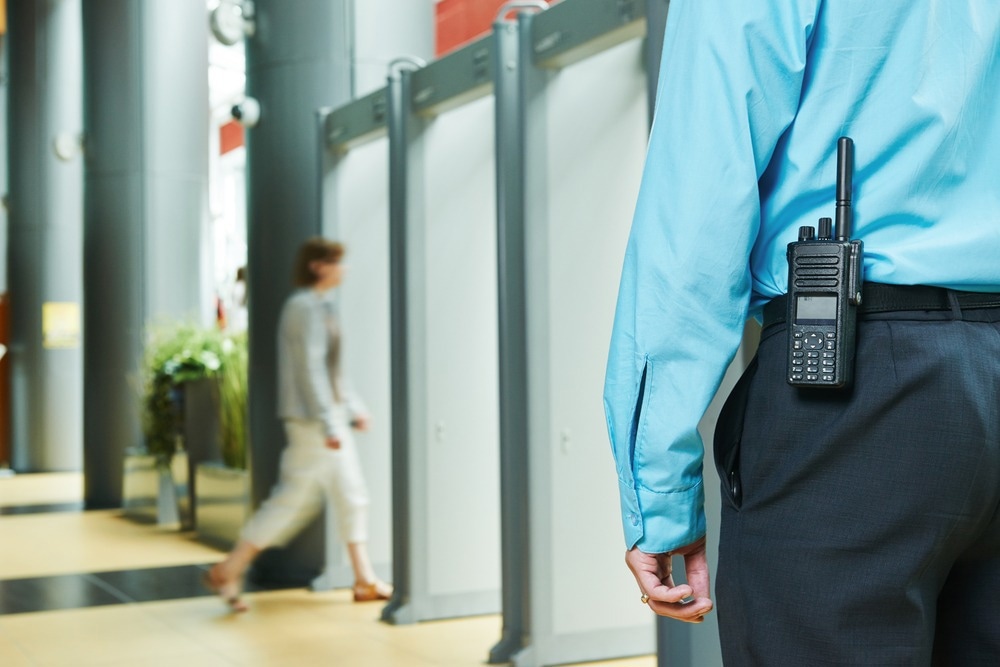Several robotics companies are at the forefront of next-generation automation in various industries, including Cobalt Robotics in the service industry. The company produces robot workers for human-interfacing security, reception, and information services, demonstrating today's mature stage of industrial robot and automation technology.

Image Credit: Dmitry Kalinovsky/Shutterstock.com
Cobalt Robotics manufactures and supplies security guard robots. These robots patrol commercial premises like office buildings, warehouses, or hotels and look for possible problems. For example, they can detect whether unauthorized people are in the wrong section of a building or if doors have been propped open. Upon detecting a possible problem, the robot sends an alert to a local human security team that can investigate the issue and respond appropriately.
Cobalt Robotics comments that this will help companies struggling to recruit security guards in a challenging labor market. According to the company, investing in robots could save companies between hundreds of thousands of dollars a year in wages to staff a 24/7/365 guard post.
To carry out automatic security guard functions, Cobalt’s robots come packed with over 60 sensors, including 360-degree 4K ultra-HD cameras, night vision, a thermal camera, a depth camera, plus LiDAR and ultrasonic sensors to control the autonomous motion system.
For communication, the robot has two-way audiovisual chat enabled, plus an LED alert, speakers, and a siren. Its vision system includes badge recognition functionality, while temperature, humidity, smoke, carbon monoxide, carbon dioxide, and ozone sensors pack extra safety sensing capacity into the robot.
The robot stands 5’1’’ (or 155 cm) tall and is finished with tensile fabric and brushed aluminum exteriors. Cobalt says that these features make it ideal for human-to-robot interaction, a key element that it expects to drive wide adoption of the system.
The Cobalt Robotics systems in deployment now do their security guard work at night and recharge during the day. However, the Cobalt Robotics research and development team is currently adding features to the robots to make them more widely applicable across service industry needs. For example, reception tasks in remote offices, such as signing in guests, taking deliveries, and sending messages, could be performed by a Cobalt robot during the day, while the same robot could become a security guard at night.
One way that Cobalt is delivering these new features on its robot products is by integrating with established automated service providers. For example, in December 2022, the company announced that its robots were now integrated with the Envoy Visitors platform, which enables visitors to provide information for companies’ visitor logs and admittance policies.
Artificial Intelligence Makes Cobalt’s Robots Stand Out
Cobalt Robotics’s CTO Eric Schultz recently gave an interview with Machine Design in which he forefronted the role played by artificial intelligence (AI) in the success of Cobalt’s security guard robot product.
Specifically, Cobalt applies large language models (LLMs) that can read, understand, and translate speech and text, as well as predicting the ideal next word or string of words in a conversation. LLMs power voice assistant AI programs like Amazon’s Alexa and Apple’s Siri.
For Schultz and Cobalt Robotics, LLMs is a universal programming language that anybody can use to ask robots a question or give them instructions. This means that their robots can be as flexible and creative as their hardware will allow them to be. Without the discursive programming that LLMs enable, Cobalt engineers would have to consider and program every possible action they think customers need the robot to do.
With LLMs, however, the robot itself is imbued with a form of “common sense” which means it can understand new instructions and break down requests into a set of achievable tasks.

Image Credit: Olena Yakobchuk/Shutterstock.com
Where Security Guard Robots Are Used Today
Cobalt Robotics has provided its robot security guards for several real-world customers today. For example, during COVID-19 Cobalt’s robots were deployed in Melbourne, Australia, hotels to ensure guests remained in their rooms.
Boston Dynamics, another fast-growing American robotics company, introduced its “Spot” robot to the market in 2019. Spot robots can get around in unstructured environments by using their dog-like four legs. The Singapore government used Spot robots to make sure public park visitors maintained social distancing in 2020. The robot would “bark” when it detected non-compliance with COVID lockdown rules.
Singapore also used autonomous drones to measure visitor numbers in its public spaces and parks during COVID-19 lockdowns. The data from these flying robots were displayed on a public website that citizens could use to find the outside spaces with the fewest visitors.
Robotics will Play a Key Role in the Future of Industry
In 2023, the leading scientific journal Nature will publish a series of articles on the “revolution in robotics and artificial intelligence” currently underway. Introducing the series, the editors compare the revolution in computing at the end of the twentieth century – taking it from laboratories and industries and into everyday life – with this revolution currently underway in robotics and AI.
Robots are already carrying out jobs like cleaning, food and parcel delivery, information services, and security. Advances in digital technology, especially in computing power and AI algorithms, will produce advances in robotics that will introduce robots to more aspects of everyday life in the near future.
As this happens, some academics have called for more public scrutiny of the still-growing robotics industry and applications of robot technology. Researchers from Australia’s Monash University recently explored how public policy could make robots more useful for the public as well as reduce undesirable outcomes like job displacement. They suggest that policymakers consider safety, privacy, productivity, aesthetics, co-design principles, systemic innovation, and ethics when making rules about using robots in public places.
Alongside policymaking and public engagement like this, innovation from companies like Cobalt Robotics can be expected to bring about a future in which robots form a welcome, safe, and useful addition to everyday life.
References and Further Reading
Begg, R. (2022) Erik Schluntz Calls Out Four Tech Trends Transforming Robotics and AI in 2023. [Online] Machine Design. Available at: https://www.machinedesign.com/markets/robotics/article/21256120/erik-schluntz-calls-out-four-tech-trends-transforming-robotics-and-ai-in-2023
LeBlanc, M. (2022) Automation can be the antidote to the security labor shortage. [Online] Cobalt Robotics. Available at: https://blog.cobaltrobotics.com/automation-can-be-the-antidote-to-the-security-labor-shortage
Mintrom, M., et al (2020) Robots in public spaces: implications for policy design. Policy Design and Practice. doi.org/10.1080/25741292.2021.1905342.
Powering up: A revolution in robotics and artificial intelligence. (2022) [Online] Nature. Available at: https://www.nature.com/immersive/robotics-ai/index.html
Thomson, L. (2022) Cobalt Robotics Announces New Technology Partnership and Industry-First Software Integration with Envoy. [Online] AZO Robotics. Available at: https://www.azorobotics.com/News.aspx?newsID=13484
Disclaimer: The views expressed here are those of the author expressed in their private capacity and do not necessarily represent the views of AZoM.com Limited T/A AZoNetwork the owner and operator of this website. This disclaimer forms part of the Terms and conditions of use of this website.